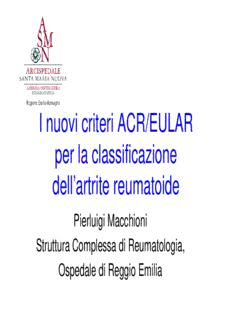
I nuovi criteri ACR/EULAR per la classificazione dell'artrite reumatoide PDF
Preview I nuovi criteri ACR/EULAR per la classificazione dell'artrite reumatoide
I nuovi criteri ACR/EULAR per la classificazione dell’artrite reumatoide Pierluigi Macchioni Struttura Complessa di Reumatologia, Ospedale di Reggio Emilia Topics • 1987 ACR classification criteria for RA • Classification versus diagnostic criteria • Limits of 1987 RA criteria • 2010 ACR/EULAR classification criteria for RA • Advantages of 2010 criteria • Limitations of 2010 criteria The 1987 ACR Criteria for the Classification of RA 1. Morning stiffness Morning stiffness in and around the joints, lasting at least 1 h 2. Arthritis in 3 or more joint areas Soft tissue swelling or fluid (not bony overgrowth) observed by a physician, present (right or left PIP, MCP, wrist, elbow, for at least 6 weeks knee, ankle, MTP) 3. Arthritis of hand joints Swelling of wrist, MCP or PIP for at least 6 weeks 4. Symmetric arthritis Simultaneous involvement of the same joint areas (defined in 2) on both sides of the body for at least 6 weeks 5. Rheumatoid nodules Subcutaneous nodules over bony prominences, extensor surfaces or in juxta- articular regions, observed by a physician 6. Rheumatoid factor Detected by a method positive in less than 5% of normal controls 7. Radiographic changes Typical of RA on posteroanterior hand and wrist radiographs (erosions or unequivocal bony decalcification localized in or most marked adjacent to the involved joints) At least 4 criteria must be fulfilled for classification for RA Diagnostic and/or Classification Criteria Diagnostic Criteria Sensitivity Not established No disease marker t i m e Classification Criteria Specificity The Treatment Paradigm for RA is Shifting Towards Early Intervention and Prevention • The need to initiate treatment early in order to prevent irreversible damage and loss of function has led to an increasing emphasis on early diagnosis and intervention Early Early intensive intensive Late symptomatic treatment with treatment Prevention treatment DMARDs with biologics 1St Clair EW, et al. Arthritis Rheum. 2004; 50:3432-43; 2Breedveld FC, et al. Arthritis Rheum. 2006 ;54:26-37; 3Bathon JM, et al. N EnglJ Med. 2000; 343:1586-93; 4Emery P, et al. Lancet. 2008; 372:375-82 5 Strategie terapeutiche Le novità “evidence based” • Il danno articolare è un evento precoce • Ritardare anche di poco l’inserimento di un farmaco di fondo peggiora l’esito • Un trattamento precoce aggressivo rallenta l’evoluzione Fase iniziale = “a window of opportunity” Some points to consider • The rate of spontaneous remission in recent- onset UA is 40-50% • Only one third of pts with UA will develop RA • MTX treatment in patients with early UA hampers progression to RA and progression of joint damage • Ideally, only the patients with UA in whom RA develops would be treated with DMARDs, • Avoid to treat patients with UA who remits spontaneously Van Aken et al, Ann Rheum Dis 2006; Tunn and Bacon Br J Rheumatol 1996; Harrison BJ et al, Br J Rheumatol 1996; Van Dongen H, et al Arthritis Rheum 2007 Major goal of RA criteria • We need criteria: - that are able to identify, among pts with newly presenting UA, a subset with high risk of chronicity and erosive damage - that can be used as a basis for starting DMARD therapy Limits of 1987 ACR criteria for RA • The 1987 criteria were based on patients in whom the average disease duration was 7 years • These criteria were derived by trying to discriminate patients with established RA from those with other rheumatological conditions • They lack of sensitivity in early disease Cohen and Emery, Arthritis Rheum 2010 Limits of 1987 ACR criteria for RA • The studies regarding the importance of Ab to citrullinated proteins in RA occurred subsequent to these criteria • ACPAs are present before the onset of RA symptoms and are predictive of RA development • ACPA assays are a valuable diagnostic test early in the course of disease Aggarwal et al, Arthritis Rheum 2009
Description: